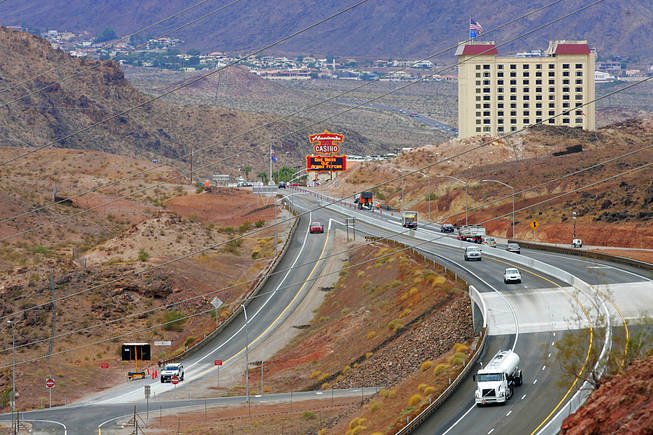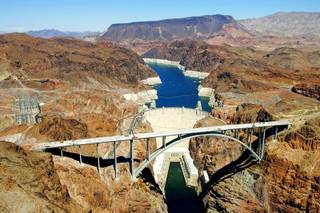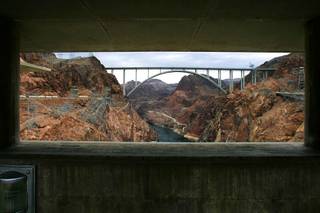
Traffic travels on the new approach road after the Mike O’Callaghan-Pat Tillman Memorial Bridge opened Wednesday, October 20, 2010.
Saturday, Feb. 12, 2011 | 1:55 a.m.
U.S. 93 and Buchanan Boulevard
Sun archives
Motorists stuck in traffic on U.S. 93 might see relief a year sooner than expected thanks to a change in funding plans and a more aggressive push from the Nevada Department of Transportation.
NDOT officials said the agency will use only state funds for the $10 million to $15 million project to widen the highway where it bottlenecks near Buchanan Boulevard in Boulder City.
Federal funds are usually utilized for such a project on a federal highway like U.S. 93, but using only state funding removes some of the approval process and lessens the environmental review required, cutting the usual two-year planning process in half, officials said.
While plans are still in the early stages, the department hopes to begin construction on the project in July or August with a tentative goal to finish construction by Thanksgiving, said senior project manager Tony Lorenzi.
The change in plans was discussed at this week's regular meeting of the Regional Transportation Commission.
The traffic problems began with the opening of the Hoover Dam Bypass in October 2010. An angry Boulder City Mayor Roger Tobler criticized the department for the traffic backups, which resulted from trucks returning to U.S. 93 after the bypass opened.
Trucks had been banned from going over the Hoover Dam since 9/11, with most of the truck traffic between Las Vegas and Phoenix going through Laughlin. That changed when the new bridge opened in October and trucks were able to return to the route through Boulder City.
The bypass created a faster, two-lane highway around the dam, but left a bottleneck near the heart of Boulder City, where traffic backups have drastically increased with the additional traffic.
In August, the city council passed a symbolic ordinance banning truck traffic from U.S. 93, and Tobler held a press conference in December during which officials from the RTC voiced support for addressing Boulder City's concerns.
The transportation department responded at the January meeting of the RTC board, of which Tobler is a member, with plans to upgrade signs and make minor improvements to the road while continuing with plans to widen it in the future.
Tobler said the response was unsatisfactory and the only way to solve the problem was to ban trucks and widen the road to increase capacity.
At the February RTC meeting on Thursday, NDOT Director Susan Martinovich announced the change in plans and said the department was moving forward to get work done more quickly.
Tobler expressed satisfaction Friday that state officials were responding to the city's pleas for help.
"It needs to be done. It should have been done a while ago," he said. "I think they're realizing if you build a bridge, you have to make it somewhat efficient. Otherwise, it's a wasted project."
Lorenzi toured the project area Thursday, looking for potential holdups, but said he found none.
Project officials held a kickoff meeting Friday with the consultants and designers working on the project, where Lorenzi said he told everyone involved that “This is an extremely expedited, fast-track project with no room for error.”
The project will still require environmental studies, but removing the federal funding will significantly speed up the process, Lorenzi said. The Federal Highway Administration is also OK with the plan, Martinovich said.
But the concept is going to require cooperation from Boulder City, the Bureau of Land Management, the U.S. Fish and Wildlife Service, the Bureau of Reclamation and the Lake Mead National Recreation Area, in addition to the project’s designers and contractors, Lorenzi said.
“We’re asking a lot of people to make this happen,” he said. “We’re asking people to move faster than they’ve ever moved before.”
In the meantime, the RTC and NDOT are proceeding with a request for the federal government to again ban trucks from the route until the project is finished. RTC General Manager Jacob Snow said a formal request should be complete in the next month.
Work on the widening project could make traffic worse in the area, making the ban even more important, Tobler said.
"We can't have the trucks coming through while we're doing this kind of construction," he said. "We're definitely still going to ask for that to be done."
Because of a lack of technology infrastructure on the route, such as traffic cameras and road sensors, the RTC didn’t have specific data proving there were traffic problems in the area.
The agency has recently installed cameras to monitor traffic and is using a Bluetooth "sniffer" to detect traffic speeds.
The sniffer recognizes when a motorist is using a Bluetooth device in a vehicle, such as a cell phone headset. Two sniffers set up along the road recognize how long it takes the driver to get from one point to the other.
While preliminary, the data show regular backups on the route, and occasional major delays when an accident occurs, officials said. The RTC has also been working with local research firm Applied Analysis to determine the economic impact of traffic delays.
About 9 percent of visitors to Las Vegas come by car from Arizona via the route, Snow said. The visitors have a spending impact of about $1.2 billion in the region each year, he said.
There is one potential negative effect of NDOT’s plan to use state funding for the project. The concept requires shifting funds from other possible road projects, Martinovich said.
The department worked with the RTC to reprioritize projects and move funds around to make the plan work. But Martinovich promised that other road projects in the state are not dying for the sake of helping Boulder City.
“The other projects are not as needed yet, so we’re not holding up anything. They’re all still in development,” she said.
Plans are also continuing to eventually build an interstate highway around Boulder City, part of a proposed Interstate 11 to connect Las Vegas and Phoenix. That project is still more than a decade away, officials said.
Sun reporter Dylan Scott contributed to this report.



Join the Discussion:
Check this out for a full explanation of our conversion to the LiveFyre commenting system and instructions on how to sign up for an account.
Full comments policy